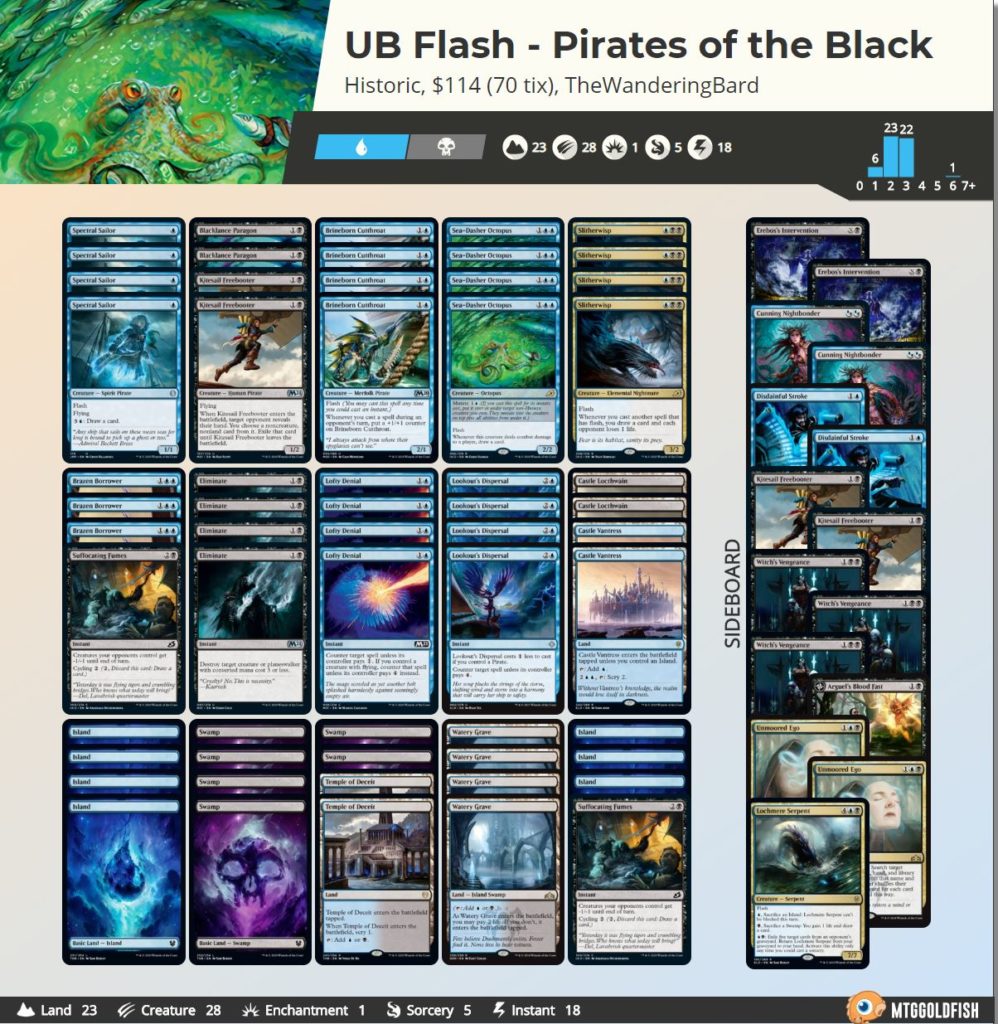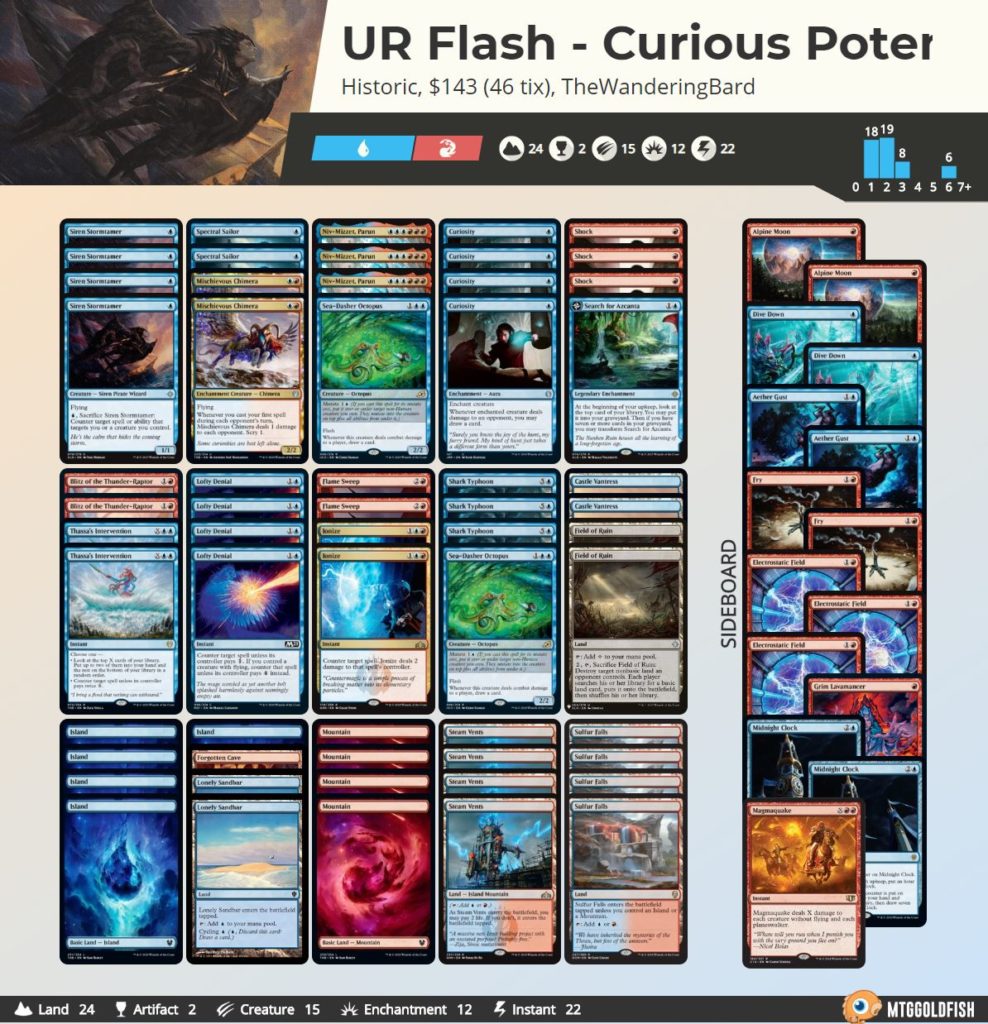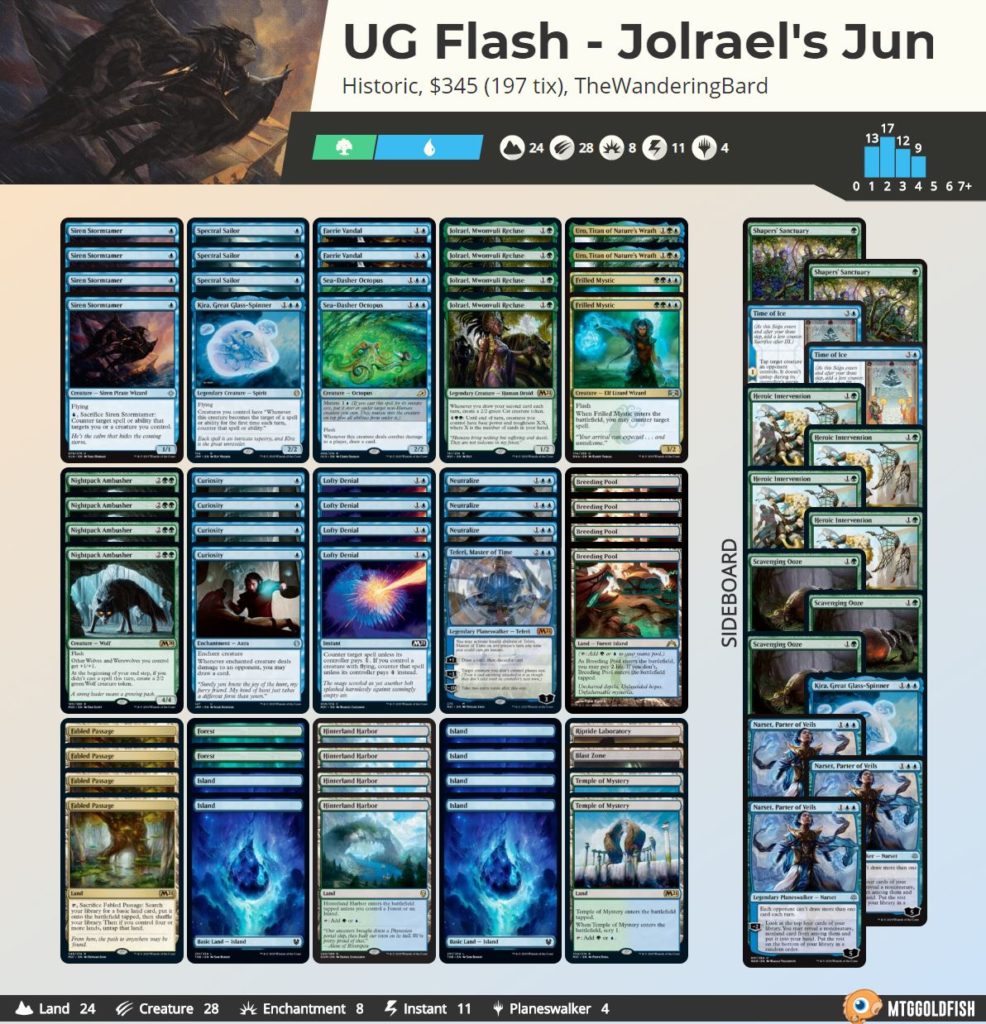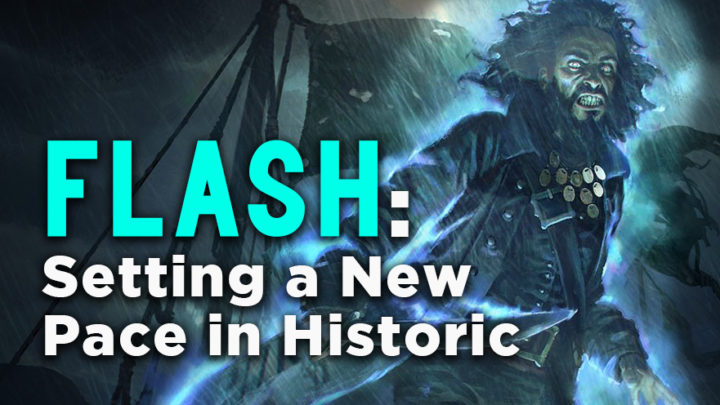Historic — and several other Magic formats — just got rocked to their foundations by this Monday’s Banned & Restricted announcement. After months of intense criticism from the player base, Wizards has decided to wipe the slate clean. Wilderness Reclamation and Teferi, Time Raveler will be mourned by few after their respective reigns of terror — but which decks are best equipped to rise in their place?
GETTING OFF TO A HEAD START
There isn’t (I hope) any one answer to that question, but blue tempo decks are a great place to start. Tempo decks — which focus on creating ongoing advantage in the first turns of the game, then protecting it with cheap interaction — were already one of the Pillars of New Historic after the great Jumpstart shake-up a few weeks ago. When the ramp decks pack late-game power and accelerate into key turns quickly, lightning aggression backed up by disruption for enemy sweepers and bombs is one of the few effective responses.
But tempo decks still have weaknesses — if not strategically, then in their consistency and card quality. Everything in these tempo decks is built for efficiency, but with Growth Spiral decks taking huge mana leads early on, it was hard for efficient answers like Mystical Dispute and Eliminate to scale up after the first few turns. Similarly, blue decks full of 1/X flyers struggle to apply any meaningful clock, giving the ramp decks time to overwhelm them with Field of the Dead, Uro, and Ugin. And of course, the ever-present Teferi was always an issue for decks that rely so heavily on instant-speed play and could ill-afford the setback of having creatures bounced.
There will still be ramp decks without Reclamation around, but they have lost their cheapest, most powerful, and hardest-to-answer threat: the mana engine itself. Either Teferi or Reclamation resolving could be close to a death sentence for blue tempo; now, these decks have far more realistic opportunities to tap out early in the game where less-than-perfect starts can get their shields up. We are also likely to see a swing back toward creature aggro and traditional control lists, even if just from people who miss playing those decks. Given that tempo can be favored against nearly anything you build it to beat, the following lists are my starting point for the new format.
BLUE CHEESE, CHOOSE YOUR OWN DIP
Specifically, I’m looking at the variants of blue tempo that can trace their origins back to the Dominaria-era Standard deck that made waves a few years ago. Why such an emphasis on blue and counterspells? Simply put, counterspells are the only wholly-effective answer for most threats we see in 2020, where even an instant removal spell for something like Ugin or Muxus, Goblin Grandee will already be too late to save you from their effects.
Blue’s Curiosity game plan is pretty close to the most potent threat you can set up by turn two, anyway. Once it’s in place, you never need to face the tough decision of when to put your shields down to develop your board — just focus on defense. It’s just too good a shell to move away from.

These core cards lay down all the essentials of the plan. Eight flying one-drops give us a great chance to set up a Curiosity draw on turn two and turn on the awesome Lofty Denial. This card has really helped the deck, which wanted to run something like Quench as a catch-all answer for early plays but couldn’t afford those small-ball cards to be dead later on. Mystical Dispute has been a go-to for many players, but having to pay three for it against speedy decks like Goblins means it can never truly fill that role. Now you have a card that reliably stops on-curve early plays and remains effective even into the late-game. Shark Typhoon (we’re here for the cycle) and Brazen Borrower provide larger air support that significantly speeds up your clock when it’s time to win, but still has utility in tight games.
When it comes to Curiosity effects, the instant-speed Octopus is head-and-tentacles above the rest, especially since you can flash it in as a creature if you’re desperate. Most builds are then left to choose between Curious Obsession and its ancestor, Curiosity. This is a toss-up, but there are fringe cases where being prevented from attacking can cost you your Obsession, or where the ability for Curiosity to trigger off non-combat damage gives it greater appeal. Again, there’s no right answer, and I’ve seen builds in tournaments that prefer both of the cheaper enchantments over the Octopus! Blue tempo presents a really nice set of sidegrade choices to customize your exact spread of flyers, counters, and draw engines, making this a great archetype if you enjoy tinkering with a list.
THE SPLASH ZONE
Mono-Blue lists have become the default, and most tournament players who had taken up the archetype before the B&R chose that familiar style. But adding a second color has more pros than cons; you gain access to proper removal and better sideboard hate. Each splash offers its own extra dimension to the core game plan, which is a real edge against opponents suddenly unsure of what to expect.
UB – THE PIRATE’S LIFE
UB Flash got some very handy support recently through Standard, and while we might not see it there until the upcoming rotation, there’s no reason not to consider the cards for Historic. The black splash adds much-needed removal for creatures and Planeswalkers that slip past your counters, along with the possibility of hand disruption, graveyard hate and life-gain. All of these can be useful as part of your 75 and guide you toward a traditional focus on 1-for-1 answers and passive card advantage.

Order this deck from Card Kingdom
Export this decklist to MTG Arena via MTGGoldfish
Speaking of the latter, we get a powerful second source of card draw from Slitherwisp! Flickerwisp’s nightmarish cousin has an acceptable body and a terrific effect that can quickly take over the game. It’s rare that designers allow this kind of engine card to have flash itself, but the ability to sequence it in whenever your opponent stumbles really makes this the black Nightpack Ambusher. I’m quite taken by this card and, at some point, I’ll no doubt try Quasiduplicating it, but we should also look at the advantages of Kitesail Freebooter.
Running simple discard spells like Duress in the main makes me wince, because any situation where they miss or come off the top when you’re both empty-handed can be incredibly costly for this sort of deck. But the Freebooter does a good enough Duress impression while also giving us an extra flyer for Lofty Denial… and an extra pirate — which, along with Brineborn Cutthroat, gives us the chance to play Lookout’s Dispersal as a second Mana Leak! Unfortunately, the remaining pirate synergies aren’t as good as our flash synergies, but you could potentially opt for Dire Fleet Poisoner as your “removal creature” over Blacklance Paragon; I just wanted a smidgeon more life-gain when I’m trading against aggro.
UR – CURIOUS POTENTIAL
On the subject of cards that improved with these bannings, I’d be remiss if I didn’t mention Niv-Mizzet, Parun. This awesome dragon caused quite a stir when he first entered Standard, inspiring memes with his hefty mana cost and then proving he was worth the difficulty. Unfortunately, Niv then became the poster boy for the “no ETB, no play” heuristic which became the norm in formats dominated by the Time Raveler. As Historic steps out from under that Planeswalker’s heel, I wanted to see whether Niv could redeem himself as the UR curve-topper.

Order this deck from Card Kingdom
Export this decklist to MTG Arena via MTGGoldfish
One point in the big dragon’s favor here is a classic EDH combo with Curiosity. Because this specific version of the effect also triggers from non-combat damage, enchanting Niv is an immediate win off any card draw, so long as your library size is higher than your opponent’s life total. We can even look to build a few smaller combos with the effect into our 75 by including other “pinger” creatures like Mischievous Chimera, Grim Lavamancer, Electrostatic Field, and Thermo-Alchemist out of the side. Of course, we’re still playing the dynamic duo of one-drop fliers, with our spread favoring Siren Stormtamer, since it provides game-winning protection to our Parun.
Red, like black, mainly offers tempo a removal package — although, in this case, the removal can also go face, which is neat. I did experiment with more traditional “counter-burn” builds that go deeper on these effects, as well as other options like Wizard Prowess or a more creature-heavy Embercleave build that I like to think of as “Blue Gruul.” But all those paths pull you away from the Curiosity + counterspells package, and I think they’re weaker for it. There are just too many threats in Historic that make Lightning Strike look bad. At least Flame Sweep, Shock, Blitz of the Thunder-Raptor and Magmaquake are all extremely useful tools against common decks in the format.
UG – JOLRAEL’S JUNGLE
UG Flash has been the most successful variant of the deck in Standard since Siren Stormtamer and Tempest Djinn rotated. But with the wider selection of cards available to all colors in Historic, it needs another look. Fortunately, Nightpack Ambusher is still an ideal curve-topper for flash decks, and we now have a second exciting engine: Jolrael, Mwonvuli Recluse!

Order this deck from Card Kingdom
Export this decklist to MTG Arena via MTGGoldfish
UG builds have always struggled most with board control, since neither color has great creature removal, and aside from Ambusher, most of your own creatures will be lucky to even trade against aggro decks. Jolrael provides the kind of free, cumulative advantage tempo decks dream about, coming down early and spitting out 2/2’s that quickly clog up the ground. Her activated ability also helps that weak clock problem, since your many flyers and tokens can easily become 5/5’s or larger once you’re ready to alpha strike.
Like Niv and Slitherwisp, Jolrael is immensely more powerful under the protection of counterspells; this is also the build that could benefit most from the addition of Kira, Great Glass-Spinner. You can tweak some of your other choices to maximize the “draw two” plan: Teferi, Master of Time as a bit of extra control, Faerie Vandal as an extra flyer, Neutralize as a second counterspell. The land base is tighter here than even the UR build, but the idealist in me demands the extra spice of Riptide Laboratory for the uber-late-game Frilled Mystic loops. (It also saves both Siren and Octopus, if that’s what you have it mutated on!)
Both Uro and Growth Spiral are good enough that you could jam them in without argument. But with this land count, Spiral is too unreliable, and in Historic, this lower curve is rich enough that you aren’t desperate to accelerate past it. Uro is worth it, much to my chagrin, simply for how well it beats up aggro and the absurd card advantage of escaping it late-game. You just can’t go past the jolly green giant…
UW – THIS ONE HAS THE SPIRIT
Spirit tribal has slowly risen in prominence since Innistrad block, but it’s never quite been a tier deck in any Arena format. I don’t think it’s quite there in Historic yet, but it does seem to be getting close.

Order this deck from Card Kingdom
Export this decklist to MTG Arena via MTGGoldfish
This is the farthest deviation from the “Curiosity & Counters” game plan, featuring the usual Spirit tribal shenanigans. Spirits combine to create an all-flying army (hard to block) with a ton of tricky effects that interfere with removal (hard to control). When the deck is good, it feels very hard to stop.
As such, this decklist includes just one counterspell and one Curiosity effect. You do get to upgrade to Staggering Insight — which, along with your lord buffs, should provide enough life-gain to race aggro decks. But Rattlechains and Sephara, Sky’s Blade help handle spot removal and sweepers, respectively, all without diluting creature count. Meanwhile, Shacklegeist and Hanged Executioner are solid answers to any dangerous creatures like Uro. Small creatures are less of a concern when your deck gets to play eight lords, so just be sure to focus on negating bombs, flyers, and sweepers. Dovin could be replaced by Icon of Ancestry as lord number nine, but I like the fallback of making flyers with the -1.
Notable sideboard cards here include actually-a-spirit Kira to further humiliate targeted removal (MAKE SURE NOT TO FIZZLE A STAGGERING INSIGHT OR RATTLECHAINS TRIGGER WITH YOUR OWN KIRA SHIELD!), Dovin’s Veto to bully decks relying on sweepers or Planeswalkers, and Rally of Wings.
Rally has a disgustingly high ceiling in a deck like this, and it is probably fine to play some number in the main deck if you want to maximize your potential best draws. It’s at its best against enemy creature decks, where you’re more likely to have a full board to use with it and where it will just mess up combat math in a race. Use it for surprise lethal or to simply untap on their turn and gobble up their ground force! It’s also tempting to play Rally against combo or any other deck where you feel pressure to kill them quickly, but in most cases, I think we’re better off leaning on our disruptive elements there; the lords should get the job done quickly enough.
ON PACE TO WIN
There you go: a tempo list for every kind of Historic player… except the ones who don’t enjoy casting counterspells. In seriousness, this sort of highly interactive deck is a great way to get your reactive, control-player kicks in the uncertain post-ban format; having that proactive clock means you don’t worry as much about having the exact right set of answers to smother opponents completely. Just trip them over and sprint to the finish!

Tom’s fate was sealed in 7th grade when his friend lent him a pile of commons to play Magic. He quickly picked up Boros and Orzhov decks in Ravnica block and has remained a staunch white magician ever since. A fan of all Constructed formats, he enjoys studying the history of the tournament meta. He specializes in midrange decks, especially Death & Taxes and Martyr Proc. One day, he swears he will win an MCQ with Evershrike. Ask him how at @AWanderingBard, or watch him stream Magic at twitch.tv/TheWanderingBard.

